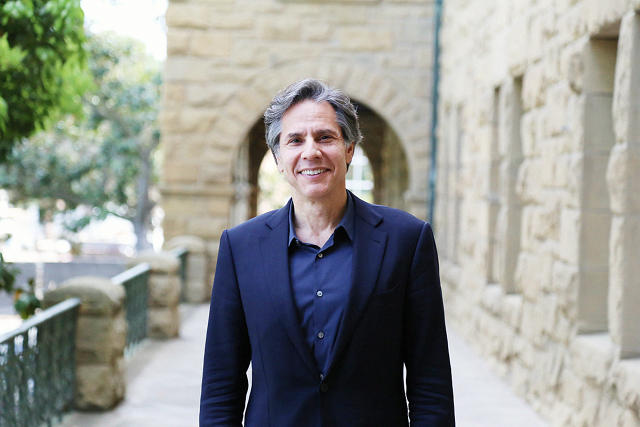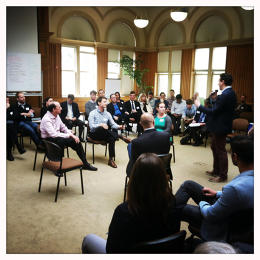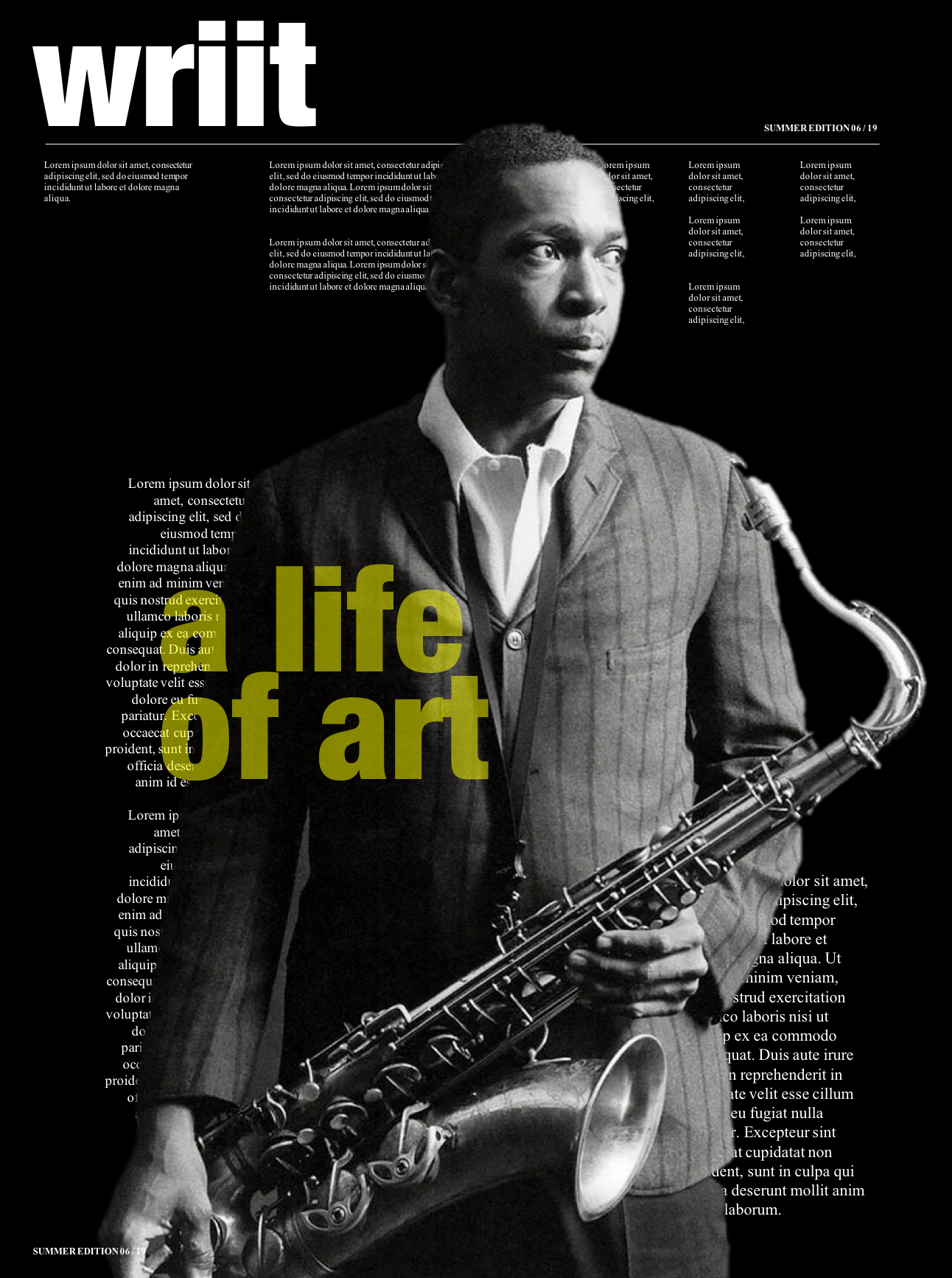The Paris and Brussels attacks got a lot of people thinking about dirty bombs. After all, what if the ISIS perpetrators had acquired a radiological weapon? Top U.S. officials have worried about nuclear terrorism ever since the Soviet Union collapsed and its warheads threatened to roll away into unsavory hands. Indeed, just last month, at the international Nuclear Security Summit, President Obama asked fellow world leaders to contemplate that very prospect. But the U.S. government is also looking to Silicon Valley, and the innovation community as a whole, to help come up with solutions to this frightening problem—and a host of other difficult issues.
Last week, members of the State Department descended on Stanford University to host a daylong brainstorming session on how to contain all sorts of weapons of mass destruction, including nukes. The 150 people who showed up were a far more eclectic group than you’d find at a usual WMD confab. Wireless executives hobnobbed with criminal investigators. Analysts from microsatellite companies traded business cards with military officers. Data-mining experts rubbed elbows with some of the world’s top disarmament officials.
Keeping track of warheads used to be relatively straightforward. Only a few countries had them, and they tended to stay tucked inside giant missiles. If you knew where the missiles were, you knew where the nukes were. It was no cakewalk, but the United States felt fairly confident monitoring Soviet military movements from space.

Now, however, it’s potentially much easier to build a radioactive bomb the size of a suitcase. Keeping track of all the “hot” stuff, that can be broken down into smaller pieces, is a fundamentally different puzzle than knowing how to spot big Russian trucks. The sophisticated containment system the world spent decades constructing isn’t suited to this new problem. That’s why some high-ranking officials—including Rose Gottemoeller, the State Department’s under secretary for arms control and international security—are embracing the notion that some of the best ideas on how to tackle the new challenge might come from people who’ve never heard of terms like “isotopics” or “dismantlement queue.” “If Amazon Prime can track billions of small objects,” Gottemoeller told the crowd at Stanford, “there’s no reason we can’t figure out how to better track WMDs.”
The workshop was the latest project in a larger innovation jag spearheaded by Deputy Secretary of State Antony Blinken. Floppy-haired, blues-guitar-loving Blinken stepped into his new role early last year as the second-in-command at the State Department. In addition to his formal duties, a deputy gets to champion a few pet projects. For Blinken, building bridges to the tech community has become one of those areas of focus. “I’ve spent 23 years in government,” he told me at a sunny campus café not far from the workshop. “More and more, it was becoming evident that many of the problems we were trying to solve were at the intersection of foreign policy and technology.” The dirty bomb issue is a prime example—it takes diplomacy to coordinate other governments in the fight against terrorism, and technology to track such hard-to-trace weapons.
Standing at a podium at Stanford, Blinken described how technological innovation is now as crucial to the State Department’s work as its traditional focus on economics and political affairs—even though the department isn’t exactly fluent in tech. As Blinken put it, sometimes it feels like “we need scientists and technologists in the room just to tell us whether we need scientists and technologists in the room.” That’s why Blinken has instituted an “Innovation Forum” at the State Department, which works on convening gatherings like the WMD workshop, and which he hopes will inspire self-starting, out-of-the-box-thinking, unconventional-solution-producing innovators in the tech community to dedicate some of their time and brainpower to tackling major international issues.
For example, in January, the State Department gathered a different group, also at Stanford, to explore ways to educate the hundreds of thousands of Syrian children now living in refugee camps. Without education, those children will have limited economic opportunities in the future—and young adults with limited prospects are especially vulnerable, as Blinken put it at that gathering, to “the siren call” of terrorism. Another meeting, in New York, explored FinTech. Historically, the United States and its allies controlled bad actors by cutting off their bank accounts using antiterrorism laws. But cryptocurrencies such as Bitcoin now let criminal networks make end runs around such controls. A third gathering in Washington sought new ways to monitor adherence to ceasefires, such as using smartphones and geolocation for crowdsourced reporting of violence.

At the Stanford WMD conference, participants were broken into small groups, where they dove into energetic exchanges about how sensors, data, and social media might help officials track fissile material—and maybe even help identify, Minority Report-style, when someone might be planning an attack. One of the participants, Brian MacCarthy, who recently opened a strategic innovations office for Booz Allen Hamilton in Silicon Valley, listened to the discussions—and was impressed. Before he moved out West, he worked inside Washington, selling products and services to government agencies on behalf of a large IT provider. “I was in D.C. for 10 years,” he noted, “and I never could have gotten this kind of a conversation going.”
Blinken’s ideas fall in line with a larger push in Washington to build more bridges to the tech sector and leverage the industry’s creative, can-do spirit to improve the way government operates. Hillary Clinton was the first secretary of state to turn to the modern tech sector for help on the international front. The Pentagon opened an office in Silicon Valley last year, as did the Department of Homeland Security. And, as this publication explored in depth last summer, President Obama has made it a priority to get all-star tech natives to do tours of duty inside the halls of government.
Still, engineering a cultural transformation at the State Department isn’t easy. Washington, like any large, powerful institution, can be set in its ways. “Just the concept of trying new things is an uphill battle,” said State Department senior advisor for tech and innovation Zvika Krieger in a phone conversation after the WMD event. Krieger told me that, when he was planning one of the earlier workshops, he invited some key D.C. stakeholders to participate—but “they were very skeptical. Their point of view was, ‘We’ve never worked with tech before, and we’ve been fine without them.'”

Krieger himself doesn’t share that old-school orientation. He’s a thirtysomething former journalist and innovation specialist who once worked for Secretary of Defense Ashton Carter back when Carter was the number-two guy at the Pentagon. Krieger is taking an iterative approach to the workshops, designing successive events based on learnings from previous ones. “We’re prototyping how we approach Silicon Valley,” says Krieger, who always seems to have a merry twinkle in his eye. “We’re seeing which formats work and what issues we should engage on.”
The difference between traditional government approaches and Silicon Valley methods were visually palpable at the WMD event. Nuclear Security Summits, which take place biannually, are solemn meetings at which world leaders sit stiffly around enormous round tables (that, ironically, and most likely unintentionally, bear an unfortunate resemblance to the ominous war room in Dr. Strangelove). The large conference room at Stanford, by contrast, was strewn with Post-it notes and Sharpie markers, and chairs were pushed aside in favor of casual small-group discussions.
By the end of the day, the teams came up with a handful of ideas—for example, testing how effective crowdsourcing can be at identifying nuclear sites in visual data, or holding a competition to see how well various sensing technologies could identify the presence of dangerous types of radioactive material in a crowded area. The participants were clearly excited by the challenge. “I’ve been working on some pieces [of my research] for 20 to 30 years,” said Kent Langley, a professor at Singularity University and a data-science entrepreneur. One of his companies has developed a platform that crunches large amounts of data to predict the intentions of potential customers, so a company can better market to them. One of the workshop small groups, by contrast, discussed how data could be crunched to figure out a potential terrorist’s intentions. The workshop, Langley said, made him realize his work could help “save lives.” “Let’s do that!” he said.
This is exactly what the State Department is banking on. Blinken and Krieger know that single daylong sessions can hardly hope to produce immediately actionable solutions, but they want to spread the message that the government no longer feels a need to retain a monopoly on solving these problems. Blinken’s team hopes top minds in the Valley and other innovation hubs will be inspired to take a stab at these big, gnarly questions. Their plan might be working. Just weeks after the workshop on Syrian education, some participants forged ahead on their own and tinkered with some of the ideas born during the session, such as using mobile phones for language instruction, or distributing tablets preloaded with educational content in refugee camps and recruiting solar companies to provide the panels needed to power them.
This kind of scrappy, just-dive-in response from Valley denizens gives Krieger hope. “In D.C., we would have spent months battling different bureaucratic hurdles to get all of the different stakeholders to buy in,” he said, “and we would have had to find the money for it when so much of our money is apportioned years in advance.”
On the other hand, Blinken and Krieger have precious little time to make headway. Obama leaves office next January. Even if a Democrat wins the White House in the fall, it’s standard practice for political appointees, like Blinken, to step down, so that incoming secretaries can bring in their own teams. Blinken’s “minimal viable product,” then, is just to produce a credible proof of concept for his meeting-of-the-minds program. “My hope is that this becomes institutionalized by the time we leave,” he said. “And that whoever follows us wants to continue it.”
Photographs courtesy of E.B. Boyd, with the exception of the mushroom cloud (via Wikipedia) and the portrait of Antony Blinken (courtesy of William Russo, State Department)
